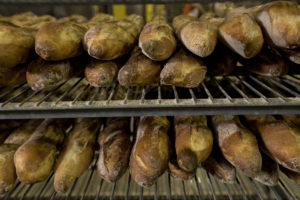Error: No feed found.
Please go to the Instagram Feed settings page to create a feed.



The Origin of Bread
bread
bred/
noun
noun: bread; plural noun: breads
So, what is bread? Basically, it’s a paste of flour and water, cooked over or surrounded by heat.
According to history, the earliest bread was made in or around 8000 BC in the Middle East, specifically Egypt. The quern was the first known grinding tool. Grain was crushed and the bakers produced what we now commonly recognize in its closest form as chapatis (India) or tortillas (Mexico).
Did you know that the Egyptians were skilled beer brewers? It’s thought that their brewing expertise combined with the warm climate, produced the world’s first sourdough…through their adding wild yeast to the bread mixture. Booze and bread, people.
Throughout the world, in the following centuries, countries developed their own versions of bread. Some leavened, others not. Romans invented water-milling around 450 BC and as such, they took bread to what was subsequently regarded as an art form. Interestingly, the richer Romans considered whiter bread as higher quality and more suited to the educated and wealthy.
Likewise, in British medieval times, bread baking became quite the status symbol. The upper classes preferred fine, white loaves, while those of poorer status were left with the rye, bran and coarser breads.
How times have changed…
By 600 BC the Persians had invented a windmill system for milling grains, and Mexicans made the first stone-ground corn tortillas around 100 BC.
It wasn’t until 1834 that the steel roller mill was invented, in Switzerland. This was revolutionary in the world of bread baking. Instead of crushing the grain, the roller system broke it open instead, thereby making it easier to separate the endosperm, germ and bran. The gluten-intolerant among us are very thankful for this invention – danke, grazia, grazie, merci.
The addition of chemicals came into play in the 20th century. Bread became whiter, softer and lasted much longer. The flour was heavily processed but the government enforced the adding back of minerals and vitamins – the enrichment of the flour. However, in the 1970s US consumption fell. In the US it rose again in the1980s, partly in thanks to bakers going “back to their roots” and producing artisan, rustic, healthier breads without chemicals or additives.
Interesting facts:
Nowadays, when we think of bread, most of us consumers think of wheat. However, as we can see from above, it can also be made from virtually any grain eg corn, barley, rye, millet, rice and amaranth.
However, note that unless you want a flat bread, you must add wheat as this is the grain that contains gluten, and it’s the gluten that is vital to a risen loaf. The word gluten comes from the Latin word for glue, and as we know, gluten sensitivity and allergy is a rather *sticky* subject for some! We’ll talk about gluten in a future post – so stay tuned!